Keywords
|
| generation, transmission, distribution, (economic load dispatch, power system security, fault diagnosis, security assessment, loads forecasting) |
INTRODUCTION
|
| The paper describes an overview on ANNs in power systems. Neural networks have been used in a broad range of Electrical applications. Artificial intelligence technologies viz., expert systems (ES) and ANNs. In recent years, another term 'intelligent control' has come to embrace diverse methodologies combining conventional control and emergent techniques based on physiological metaphors, such as ANNs ,fuzzy logic, ANNs have been studied for many years with the hope of understanding and achieving human-like computational performance. The benefits include massive parallelism, architectural modularity, fast speed, high fault tolerance and adaptive capability. NN applications to power systems can be categorized under three main areas: regression, classification and combinatorial optimization. Applications involving include transient stability analysis, load forecasting, static and dynamic stability analysis. The area of combinational optimization includes unit commitment and governing control. |
OVERVIEW OF ARTIF'ICAL NEURAL NETWORK
|
| An Artificial Neural Network (ANN) as a computing system is made up of a number of simple, and highly interconnected processing elements, which processes information by its dynamic state response to external inputs. In recent times the Study of the ANN models is gaining rapid and increasing importance because of their potential to offer solutions to some of the problems which have hitherto been intractable by standard serial computers in the areas of computer science and artificial intelligence. Neural networks are better suited for achieving human-like performance in the fields such as speech processing, image recognition, machine vision, robotic control, etc. |
ARTIFICIAL NEURAL NETWORK MODELING
|
| Artificial neural Networks (ANNs) are made up of a number of simple and highly interconnected Processing Elements (PE) called neurons. The basic computational element (model neuron) is often called a node or unit. It receives input from some other units, or perhaps from an external source. Each input has an associated weight w, which can be modified so as to model synaptic learning. The unit computes some function of the weighted sum of its inputs which are shown in fig… |
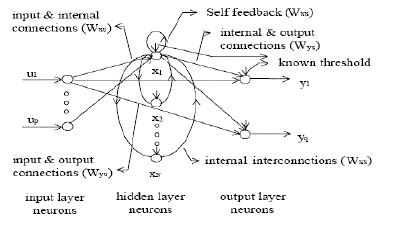 |
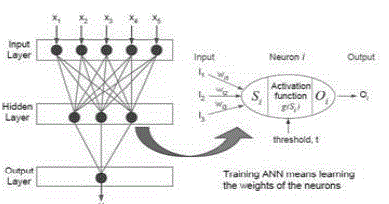 |
| Oi = f (ΣWij Ij) |
| • Its output, in turn, can serve as input to other units. |
| • The weighted sum is called the net input to unit i, often written net. |
| • Note that wij refers to the weight from unit j to unit i (not the other way around). |
| • The function f is the unit's activation function. In the simplest case, f is the identity function, and the unit's output is just its net input. This is called a linear unit. |
DIFFERENT TYPE OF ANN ARCHITECTURE
|
| SINGLE LAYER PERCEPTRON (SLP) MODEL- Perceptron is the simplest single layer network, considered as a linear classifier. The principal weakness of the perceptron model is that it can only solve problems that are linearly separable. However, most of the real world problems are non-linear in nature. |
| • MULTILAYER PERCEPTRON (MLP) MODEL- A Multilayer Perceptron (MLP) is a feed forward neural network model that maps sets of input data onto a set of appropriate output. It is a modification of the standard linear perceptron using three or more layers of neurons (nodes) with nonlinear Activation functions. Hence, it is more powerful than the perceptron as it can distinguish data that is nonlinearly Separable. The basic structure of a MLP network used for simulation in this work is shown in Figure. The Network consists of an input and an output layer with one hidden layer of nonlinearly-activating nodes. Each node in one layer connects with a certain weight wij to every other node in the following layer. The Number of neurons in the input layer is same as number of input features and the number of neurons in Hidden layer is chosen as 30 with ‘hyperbolic tangent sigmoid’ activation function. The network is trained with back propagation algorithm. |
| • HOPFIELD NETWORK - Hopfield networks are constructed from artificial neurons. These artificial neurons have N inputs. With each input there is a weight associated. They also have an output. The state of the output is maintained, until the neuron is updated. Updating the neuron entails the following operations: |
| • The value of each input, xi is determined and the weighted sum of all Inputs i wixi is calculated. |
| • The output state of the neuron is set to +1 if the weighted input sum is larger or equal to 0. It is set to -1 if the weighted input sum is smaller than 0. |
| • A neuron retains its output state until it is updated again. |
| A Hopfield network is a network of N such artificial neurons, which are fully connected. The connection weight from neuron to neuron is given by a number w. The collection of all such numbers is represented by the weight matrix W, whose components are wij. The main application of a Hopfield Net is the storage and recognition of patterns, e.g. image files |
| • RECURRENT NETWORK – A recurrent neural network (RNN) is a modification to this architecture to allow for temporal classification, as shown in Figure. In this case, a ″context'' layer is added to the structure, which retains information between observations. At each time step, new inputs are fed into the RNN. The previous contents of the hidden layer are passed into the context layer. These then feed back into the hidden layer in the next time step. In an algorithm similar to the back propagation algorithm, called back propagation through time (BPTT), the weights of the hidden layers and context layers are set-to do classification, post processing of the outputs from the RNN is performed; so, for example, when a threshold on the output from one of the nodes is observed, we register that a particular class has been observed. |
| Depending upon then training Imparted, ANN can be classified as supervised ANN or unsupervised ANN. |
| • Supervised ANN - The supervised ANN requires the sets of inputs and the outputs for its training. During the training, the output from the ANN is compared with the desired output (target) and the difference (error) is reduced b y employing some training algorithm. This training is repeated till the actual output acquires an acceptable level. Supervised ANN may be a feed forward or non recurrent network such as Multi Layer Perceptron (MLP), Functional Link Net (FLN) and Radial Basis Function (RBS), or a feedback or recurrent ANN such as Hopfield network, often used in power system applications. |
| • Unsupervised ANN - The artificial neural network which does not require a supervisor or teacher for training is known as unsupervised ANN. In competitive or unsupervised learning units of the output layer compete for the chance to respond to a given input pattern. Kohonen's Self-Organizing Feature Map (SOFM) and Adaptive Resonance Theory (ART) are examples of unsupervised learning. |
| • Reinforced Learning - Reinforcement Learning (RL) is characterized by relatively infrequent and general feedback/reinforcement (as compared to the frequent and specific error signals of supervised learning) that must (somehow) translate into credit assignment to specific system components whose temporal activity histories have varying degrees of overlap with the actual time of the reinforcement. For example, if a child kicks off his slippers, then runs wildly around the living room before diving onto the sofa and ripping mother’s outstretched newspaper, the ensuing reinforcement (mother’s loud, angry yell) indicates that something in the child’s recent sequence of actions must change. Whether the true problem lies in the child’s slipper removal, or wild running, or diving, or violent collision with the newspaper, is left for the child to sort out. In short, the child must perform a credit assignment problem relative to the component behaviors of his recent action sequence. |
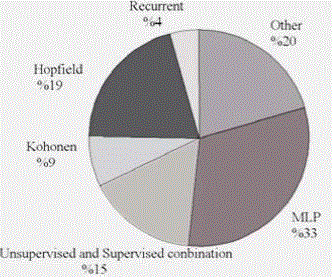 |
ANN APPLICATIONS IN POWER SYSTEM
|
| Several key features that distinguish NNs from other AI techniques are: learning by example in real time, distributed memory and associated amount fault tolerance and graceful degradation, real time pattern recognition, intelligent association. Despite its numerous advantages, distributed memory causes a major flaw in NNs, because knowledge in a NN is structured as a pattern of weights and connections. Other stumbling blocks and how training work is going on to tackle them are discussed in the section of stumbling block. This section aids with typical ANN application areas in power systems. The various areas are: - Security assessment, transient stability, fault Detection and diagnosis, control analysis, protection and design. Most popular problems are: (i) load Forecasting (ii) security assessment and (iii) Fault detection & diagnosis. |
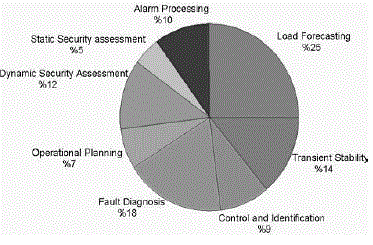 |
| • LOAD FORECASTING- Load forecasting is a suitable problem for ANN application due to the availability of historical load data on the utility databases. ANN schemes using perceptron network and SOFM have been successful in short-term as well as long-term load forecasting with impressive accuracy. A combined use of Unsupervised and supervised learning was done for short-term load forecasting. Filter based an" algorithm for faster convergence and improved prediction accuracy. The RBF (radial basis function) network was found superior to MLP or BP model in terms of training time and its accuracy. ANN does not need additional memory for storing the history of load patterns. 1% improvement in accuracy of STLF can save up to Rs. 700 million for a typical power utility. |
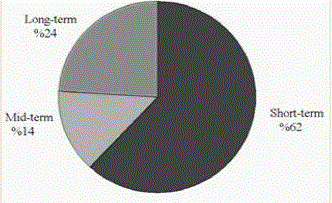 |
| • Security Assessment – Static and dynamic security assessment often requires on-line computation. In order to evaluate solution efficiently, the nonlinear mapping of MLP is utilized to reduce computational burden and &deal with the Characteristics of power systems. This allows us to carry out on-line monitoring/assessment in transient, small signal stability, and voltage instability. Though |
| Contingency ranking and sensitivity factor methods have reduced the Number of critical contingencies to be computed, ANNs has played a challenging role in security area. |
| The security assessment is based on, |
| * Knowledge of system dynamics |
| * Measurement of system variables |
| * Models for measurement uncertainty and system disturbances |
| * Well-defined criterion for security. |
| Maximal admissible currents of the transmission give the boundaries of the secure Domain of the state space (operating point are defined by a vector whose components are Active and reactive power). |
| • Fault Detection/Diagnosis – Fault detection/diagnosis is one of challenging problems in power systems. MLP identifies the type and location of faults with a given set of power system conditions, measurements, alarms, etc. KN (Kohonen net) is applied to handle the classification of fault patterns. The diagnosis of the power apparatus is done to judge what kinds of faults the apparatus suffered from and then accordingly it is cleared. KN is inferior to MLP in terms of the solution accuracy due to unsupervised learning. RBF and BP models were developed for fault diagnosis problem. The BP network had given superior performance while training of RBF network was much faster as compared to BP network. |
| • Economic Load Dispatch- The economic load dispatch (ELD) problem is one of the important optimization problems in a power system we presented a method to solve ELD problem with piecewise quadratic cost function using Hopfield NN. The ANN based approach turned out to be much simpler and accurate. It deals with combined ED and emission dispatch using improved BPNN. Adaptive Hopfield NN is recently used for ELD. Traditionally, in the ELD problem; the cost function for each generator has been approximately represented by a single quadratic function. It is more realistic, however, to represent the generation cost function for fossil fired plants (thermal, nuclear etc) as a segmented piecewise quadratic function. Some generation units, especially those units which are supplied with multiple fuel sources (gas and oil), are faced with the problem of determining which the most economical fuel to burn. As fossil fuel costs increase, it becomes even more important to have a good model for the production cost of each generator. Therefore a more accurate formulation is obtained for the ELD problem by expressing the generation cost function as a piecewise quadratic function. This approach can be applied to generators supplied with various fuels as well as valve point loading problems. |
STUMBLING BLOCKS
|
| ANN faces several problems to be solved in spite of attractive features discussed & the main difficulties with ANN implementation are discussed below. For Optimal Structure of ANN It is essential to design the network size (the number of input and output neurons in MLP, and the number of output neurons in KN). Further, training is necessary to obtain more reasonable models. |
| • Other Efficient Learning Algorithm- The BP algorithm requires many iteration counts. It is not suitable for on-line learning scheme. It is necessary to have a learning algorithm with better convergence. Efficient global optimization technique is needed to evaluate the weights. Alleviation of "Curse of Dimensionality": The direct application of ANN to large scale real-size power system requires large-scale ANN. It is not easy to find out the optimal weights in terms of accuracy and the computational effort. |
| • Consideration of Network Topologies- We have to cope with network topologies if the problem is related to transmission lines. Actually, ANN applications to one or several snapshot are not convincing. Necessary Amount of Learning Data: The efficient method for finding out the necessary amount of the learning data is not available in constructing ANN. The inefficient data creates inappropriate models while too much data needs excessive computation time. It is normal that in spite of good performance on training data, worse performance is obtained on test data. This may be due to the Fact that the training details are not uniformly distributed. The accuracy of ANN model depends on the number of training patterns in a given range. |
FUTURE WORK
|
| Research would continue to enhance ANN performance. It is a natural research that Want to make use of other emerging technologies to overcome drawbacks o f existed systems. It is known that ES, FS (fuzzy system), genetic algorithm (GA) and ANN have strong credentials to deal with uncertain, example and noise polluted data. ANN is a good approximate of performing well for non-linear system. FS, GA, chaotic dynamics are generally used to embrace quality and reduce the training time and performing of the ANN, Fine training or defuzzication can be done by ANN. |
CONCLUSION
|
| Neural network based application are robust, sustainable and finest among recent development trends. Even if input data are not complete or have some noise, the ANN can still give good results. ANNs have adaptive ability and can adjust to the new very easily. Modern control techniques like adaptive, variable structure can be learned by ANN from a series of training sets and once the learning phase is over ANN can be used as a robust controller. Special purpose hardware designed to implement and evaluate ANN technologies and variety of NNS (e.g. recurrent network) are being seriously tried for solving PS problem. An overview on ANNs in power system has been presented in this paper. This paper has focused on MLP, HN and KN as typical ANNs. It may be seen that, MLP is the most popular among to the supervised learning that is superior in terms of accuracy. As the application areas, are load forecasting, security assessment and fault detection/diagnosis were of main importance though there exists a variety of application areas. The present day prime difficulties and their proposed solutions are reviewed finally; the integration of ANNs with other emerging technologies such as FS, GA etc. was discussed as a future research direction. |
| |
Figures at a glance
|
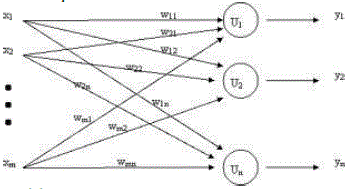 |
 |
 |
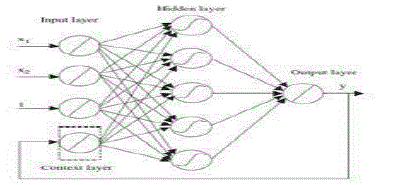 |
| Figure 1 |
Figure 2 |
Figure 3 |
Figure 4 |
|
| |
References
|
- I.J. Nagrathand D.P. Kothari, ‘power System engineering", Tata McGraw-Hill, New Delhi, 1994.
- D.P. Sengupta et al.,"Recent Advances in Control and Management of Energy Systems", Ch. 15 by P.K. Dash, Interhey 1993.
- M.El-Sharkawi and D. Niebur (Eds.),'TEm Tutorial Come on ANNs with Applications to Power Systems", % TP 112-624
- NPSC Tutorial Course, I.I.T. Delhi, 1994.
- H.Singh, M.S. Sachdev, T.S. Sidhu "Design, Imple- mentation and Testing of an Arti_cial Neural Net- work Based Fault Direction Discriminator for pro- tecting Transmission Lines," IEEE Transactions on Power Delivery , Vol. 10, No. 2, 1995, pp 697-706.
- A.L.O Fernandez, N.K.I Ghonaim, "A Novel Ap- proach using a FIRANN for Fault Detection and Direction Estimation for High Voltage Transmission Lines," IEEE Transactions on Power Delivery, Vol. 17, No. 4, Oct 2002, pp 894-900.
- A. Bennett, A. T. Johns, Q. Y. Xuann , R.K Agarwal, R. W. Dunn, "A Novel Classification Technique for Double-circuit lines Based on Combined Unsuper- vised/Supervised Neural Network," IEEE Transac- tions on Power Delivery , Vol. 14, No. 4, 1999, pp 1250-1255.
- T.S. Sidhu, L. Mital and M.S. Sachdev ,"A Com- prehensive Analysis of an Artificial Neural Net- work Based Fault Direction Discriminator," IEEE Transactions on Power Delivery, Vol.19, No. 3, July 2004, pp 1042-1048
- U.S. Department of Energy: Assistant Secretary, Conservation and Renewable Energy, Office of Energy Systems Research, "Research Progress in Dynamic Security Assessment", Report DOE/ET/29038-1, Prepared by: The Analytic Sciences Corporation One Jacob Way, December 1982.
- Germond, A.J., N. Macabrey and Thomas Baumann, "Application of Artificial Neural Networks to Load Forecasting," same source as [5], pp. 165-171.
|